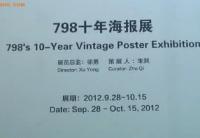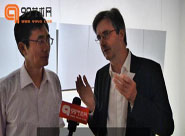UP UP Down: A device to play
Man with rooster head and Huang Jue Planet: Serial Painting
My childhood was too early to experience the massive stream of Japanese Comic, instead, besides TV, the most popular in my time was supposed to be “Strip cartoon”, also named as “strip cartoon series”. These scattered images are always connected with one and another with their own codes and rhythm, no intentional content or script needed.
Xu Qin's drawing seems to be the zoom-in of this memory.
To this effect, pursue of all the skillful techniques including texture, strokes, Brightness, structure or space has compromised to the story itself. The images mostly narrate artistic fictions and imaginations blended in the real world we are familiar with in the meanwhile.
《Huang Jue Planet》 is where the story taken place, as well as the very first stage of the artist's latest series. Most of the scenes followed were performed here one by one. The reason why this scene has been chosen might not be anything special as it’s at where Xu Qin and most of his friends spend everyday. The Main character of 《Huang Jue Planet》wears a hat resembles rooster head, holding a bowl of noodles with his thumb abruptly sticking into the soup. This is a common scene while dining out on Huang Jue Street where most of the venders serve their food together with their fingers showing you black nails containing all the possible dirt which is always too frightening for me to see. Fortunately the artist didn't really pay much attention to this trivial. Everything scattered in this planet are views and scenes we can see on this street in real. The landmark construction-the power plant, for instance, with two giant chimneys with strips in red and white standing above the clouds; the tanks, marching through the square in some of those sunny days, while where they used to be parked has been rebuilt by Sichuan Fine Art Institute into Tank Loft · Chongqing Contemporary Arts Center, which will soon become the new landmark of contemporary arts; the buses, heading from Huang Jue Square to Wal-Mart, the closet large supermarket with cinema on the 5th floor, 50% discount every Tuesday; and the artist's friend sitting in his old work named "The Three Wheeler" - renamed later 《Ferrari》by himself; Also the robot, the transformation of another mobilizing scene in Chongqing called “Bang Bang" (hammal who serve as public transport for all types of cargo) who used to be a large group of people who survive by providing physical work and nowadays many of who has turned to be part-time artists at Huang Jue Square.
Just like the famous block-buster movie 《Star War》 and any other stories about outer space discovery, this planet always encounters unprecedented changes upon the main character's arrival. 《The Lost Planet》, reveals the first one for us: the main character still wears a rooster head mask veiling his facial expressions and, the cold and hard helmet turns the tiny drop of tear hanging on the corner of his eye even more weird and mysterious. Thunders and lightening up above, rolling waves behind, the chimneys stands inclined towards the water; the buses to Wal-Mart turns into little boats; the artist’s friend rides on a water motorcycle; the robots waves their hands and asks for help…….yet the rooster head man holds a showerhead which is still dropping, which leaves us wonder if he's the reason that all this sad episode should be blamed for or the hero who comes to save the world with his magnificence.
《FALLOUT Planet》is the following episode of this disaster: the power plant collapse causes earth cracking and lava and monsters come out from the ground; robots start to stir up some uprisings; bus to Wal-mart is forced to change its itinerary; the artist’s friend has to give up his ride and escape in disguise…… a frown comes up on the rooster head man and against the light this hat looks grave.......
Tragedy never happens again. Then 《Huang Jue Ark》arises with the same mission of leading all the lives escaping from this planet, resemble Noah in the Bible. Instead of sailing in the ocean, this time the ark has experienced a travel spree in the outer space; the main character driving a rooster-head spaceship with remote control holding in his hands, which turned out to be one of the steps in a program been completed other than an escape.
It seems that we always need some spiritual comfort after disaster like this, classic script from “A Journey to the West” has been adopted into the next episode - 《Liusha River》 portrays a modern version of the master Tang and his three apprentices taking the ark and landing on the Huang Jue planet where yellow sands are everywhere, notably the best directional signs as the landmark chimneys and the group of robots. When the entire earth turns into a desert, the only place with liquid surprisingly points to famous artist Damien Hirst's work –《 A shark soaked in Formaldehyde》. This idea must be creative flattering enough to make each and every artist proud of themselves.
Splendid narrating and epic chapters compromised to the subtle emotions by the end. When Xu Qin's working on 《Titan-earth》, he was in an indescribable emotional moment, so the final episode ends with the main character standing on the yellow spaceship while staring at the stars twinkling in the empty sky. The end leaves us wonder if he was trying to say goodbye to or rather welcoming his pink-dressed friend floating in the air right in front of him. If “Titanic" is a story about sweet romance and love, 《Titan-earth》, with a gold-like color, has brought out more blue and gray feeling.
……The story still goes on and on, as the main character wonders around at Huang Jue Square, drinking milk tea, eating hotpot…… all the images seem to be so absurd and real. In Xu Qin’s paintings, I can always find what are happening around me every and each moment of the day and, watching those people, things and objects that we are familiar with changing their roles in different works of this artist. There seems to be an invisible string hiding behind all these differed stories and this is absolutely the awkward moment that I feel my imperfect narrating skills is not able to connect all the clues to one pending puzzle, just like the “Sherlock Holmes” by English author A. Conan Doyle. At times I also feel confused that the main character on those images, this mysterious man who always hide behind the rooster head mask, is just another me under the artist’s portray. In the story, when he was stuck in the art world which combines reality with fictions, he became maniac, upset, thrilled, forgetful and sensitive; he was confused, fussy, fanciful and unstrained; obsessed by the fact of growing up with anticipation for emotions, desires, and imaginations, he was active and impulsive, like any other youth of this century.
Perhaps, “strip cartoon" has already faded out from our sight with the heavy strike of TV and Internet, and also turned to be less relevant to the most updated and edgy contemporary arts. Xu Qin's paintings seem to be less advantageous, however, visual perception is memorable. When the bigger version of this “ strip cartoon” is represented in front of all of us, our visual emotional memories and image-reading nature will be automatically activated, which turns either watching or reading to be a very relaxing and pleasant experience.
【编辑:小红】

